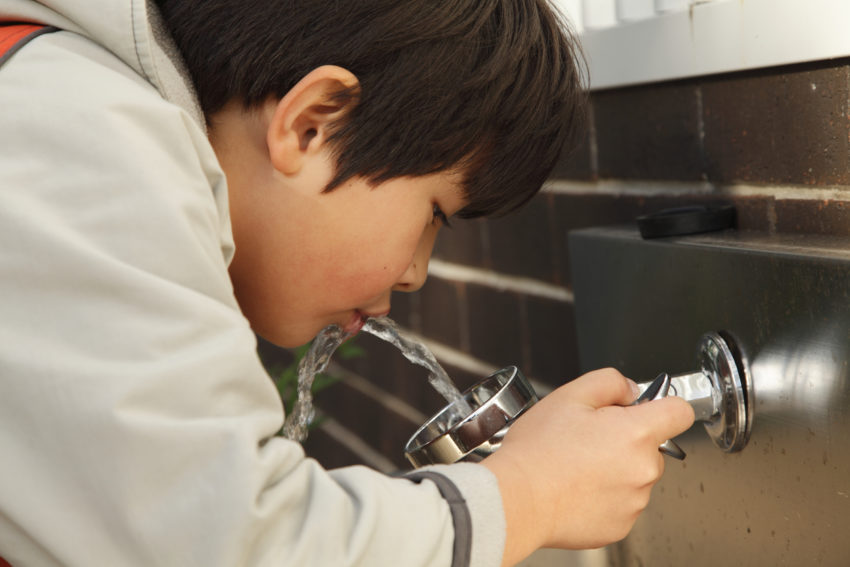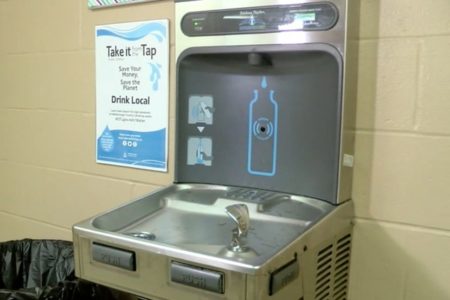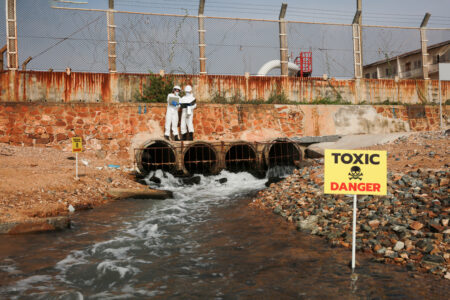
Share On Social!
Children are meant to learn and thrive while at school — not face harmful lead exposure through the water supply.
Unfortunately, schools in at least 22 U.S. states failed to protect students from water contamination, including lead. This kind of exposure can cause a host of health complications to arise, including nervous system damage and learning disabilities, especially in young children.
This is a huge problem, according to Joan Leary Matthews, a senior attorney and director of Urban Water at the Natural Resources Defense Council (NRDC).
“It’s everywhere,” Matthews said in an interview with Salud America! “Here’s why. There’s no such thing as lead-free plumbing. Federal law has limited the amount of lead that can be in new fixtures.”
Why is Lead Possibly in My Child’s School?
Throughout schools across the country, lead can seep from plumbing, fixtures, and fittings and enter that building’s water. 
That harmful substance will make its way into the children’s systems who drink from those supplies.
Medical professionals across the board agree that vulnerable groups—the young, pregnant women, and the elderly—should not allow any lead in their system. Despite that, the EPA only sets voluntary guidelines for schools.
The current law states that plumbing, fixtures, and fittings containing up to .25% of lead can be classified as “lead-free.”
Worse, the problem is widespread, according to Matthews.
“Before the [.25%] change in the law, it was up to a whopping 8%,” Matthews said. “So, we know there is lead in fixtures and plumbing. We’re also concerned that in communities like Newark or Flint, that have had corrosive water coursing through the drinking water systems, that water—which doesn’t have corrosive water control— can dislodge lead from lead service lines.”
What About Those 5 Tips?
The NRDC recently published a variety of resources that can help any parent ensure their child is drinking safe, clean water.
“Parents are thinking about this, saying ‘What do I do? I’m not a scientist,’” Matthews said. “We wanted to give some common-sense tips on what they can do.”
Their main recommendation?
Send kids to school prepared to avoid the unfiltered water fountains.
NRDC’s five tips to protect their kids from potentially tainted water at schools: 
- Pack filtered water in a water bottle for your child every day (some teachers allow spill-proof water bottles in classrooms)
- Spread the word about safe water concerns by talking to your child’s teacher and the school nurse
- Ask the school principal whether the drinking water has been tested and ask for test results
- Raise drinking water safety and lead concerns with your parent-teacher organization; advocate that your school or the school district install filters to remove lead from drinking water fountains and taps
- Talk to your pediatrician about your concerns regarding lead in drinking water
More importantly, parents can work to protect all children in their town by advocating for a filtered water bottle fountain at their school using Salud America!’s action pack!
ADD A WATER BOTTLE FOUNTAIN IN YOUR SCHOOL!
For free, parents and community leaders will receive:
- Customized, click-to-send emails, graphics & resources
- One-on-one support from an Action Pack Coach
- Promotion of your efforts to 250,000+ change-makers
While lead in the public water supply isn’t an issue that will go away tomorrow, Matthews said unified action is what makes a difference.
“This is everybody’s problem,” Matthews said. “It is a community problem. When you’re organized, you can leverage your power — especially for asking questions and getting answers. When you’re within an organized or unorganized group, school administrations tend to listen and address your concerns.”
Editor’s Note: This article is part of a collaboration between Salud America! and the Hoffman Toxicant-Induced Loss of Tolerance (TILT) program at UT Health- San Antonio. To find out if you are TILTed due to exposure to everyday foods, chemicals, or drugs, take a self-assessment or learn more about TILT.
By The Numbers
1
Quick Survey
Can help you find out how chemically sensitive you are



